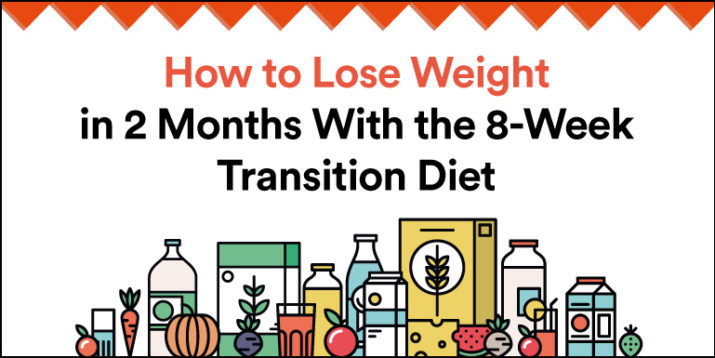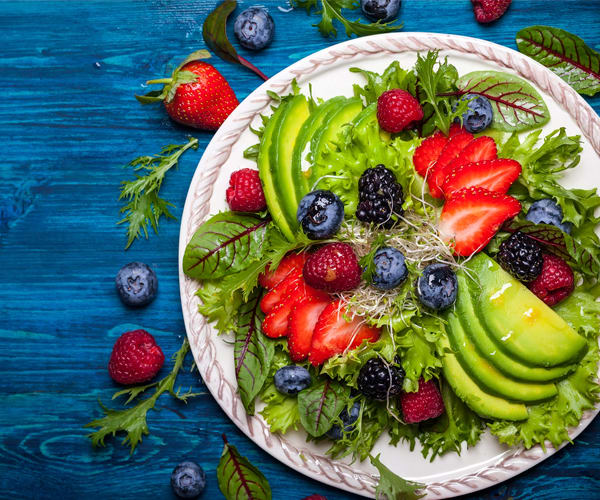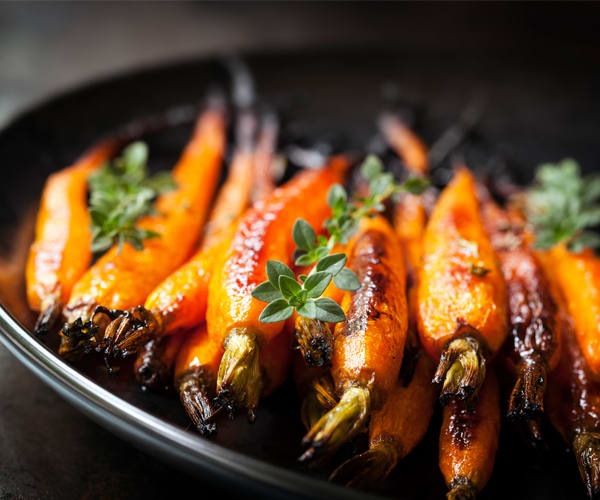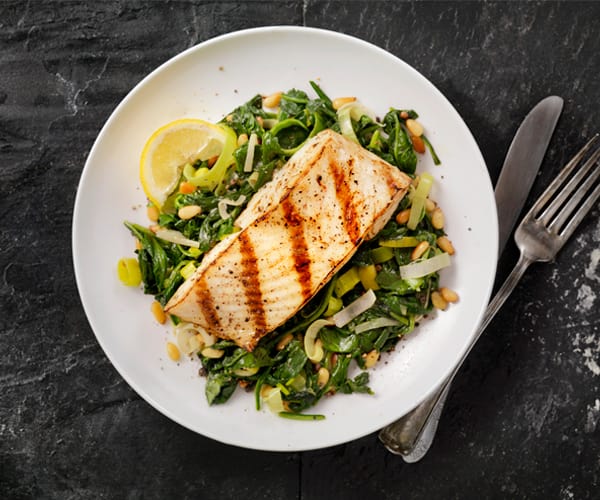Start Eating Clean with the 8-Week Transition Diet

It’s often said that no one diet or way of eating works for every individual. While this is true, you may have noticed that all BODi eating plans target a similar goal: eat more natural, whole foods and less junk (processed foods, fried foods, treats, and drinks loaded with sugar).
Known these days as clean eating, this style of eating is the healthiest, simplest way to lose weight, improve body composition, and perform better.
Notice I said “simplest,” not “easiest.” If it were easy to forego french fries, chocolate chip cookie dough, and blended strawberry daiquiris, you wouldn’t be reading this article. With the wide availability and inexpensive cost of unhealthy foods — from cheap chain restaurants and fast food drive-throughs to junk-food vending machines and Girl Scout cookie drives — we live in a world where you have to try pretty hard in many cases to eat clean.
Ideally, clean eating should become a lifestyle, not some quick-fix diet. But, embracing clean eating fully is a process. You don’t have to be perfect all the time. That’s why the 21 Day Fix program permits a reasonable allowance of cheats and treats. But, if you want to reap the many benefits clean eating offers (weight loss and healthy weight management become happy side effects), then you need to start learning how to change your unhealthy eating habits.
Transition diets are one of the easiest ways to gradually introduce the concept of clean eating into your life. They’re not only ideal for those new to healthy eating, but they are also great for any time you need to clean out your system after a period of slacking off. That’s why I do a variation of this plan almost every year.
The 8-Week Transition Diet is for those who want something simple. Outside of a small list of what you can’t eat, you’re free to chow down on anything. How hard can that be? You should also find that by making your transition gradually, the road to clean eating becomes pretty easy.
Pro tip: Pin or print out the infographic below to help you stay on track!
A Week-by-Week Breakdown of the 8-Week Transition Diet
Week 1
Week 1 rule: No junk
Eliminate junk food from your diet. That’s it, just junk. Other than this, you can eat whatever and whenever you like. The definition of junk is obvious stuff, like potato chips, candy, ice cream, cake, etc. You may be stricter if you’d like, but for Week 1, don’t be too hard on yourself. Just stay out of 7-Eleven. For many of you, this step alone will reap huge benefits.
Week 1 number of cheat days: 2
Since no one’s perfect, you get 2 days to cheat. That’s right, 2 days where you can eat anything you want!
A trick on cheat days is to listen to your body. At first, it’ll probably tell you it wants whatever you’ve been denying it. However, over time, it’ll start to crave nutrients in which you’re deficient. Learn to read your body’s subtle signs. If you’re craving ice cream, you may be short on essential fatty acids. If you crave a hamburger, your diet may lack protein.
By listening to your body and learning what it really needs, you can make better food substitutions. It’s a way of getting in tune with yourself that will benefit you for the rest of your life.
Week 1 focus: Water
Not swimming in it, though that’s good too, but staying hydrated with it. “They” say you should drink at least six to eight glasses of water per day, but I say you should drink more. Shoot for a gallon (though don’t worry if you fall short). Yeah, that probably seems crazy, but almost all of us walk around dehydrated for most of our lives, which not only hurts the way we function but also makes us hungry when we’re actually thirsty. A glass of water when you feel hunger pangs both staves them off and helps you fill up faster when you do eat.
As for other drinks, juices and sugary sodas fall into the junk category. And alcohol should be kept to a minimum. We tend to forget (purposely or not) that alcohol has calories — a lot of them, about 7 calories per gram. Mixers can be even worse; they add calories, and the sugar influences the way alcohol reacts with your body.
When you do drink, opt for the purest form of alcohol you can find (examples: 100 percent de agave mezcal, wine that’s low in histamines and sulfites, or a craft beer) and don’t mix it with anything — except maybe sparkling water. Stick to only one or two drinks, and make sure to sip water alongside your adult beverage.
Week 2
Each week’s rules are cumulative, so the “no junk” rule from Week 1 will apply until the end, as will each subsequent week’s rule. Remember, this is a process. Treat it as though you’re in school and the subject is your own body.
Week 2 rule: Eat small, eat often
Eat every couple of hours while you’re awake, and try not to eat anything for about 3 hours before you go to sleep. Following these rules will keep your blood sugar levels more static and your energy level will stay consistent.
Try to keep each snack or meal balanced. Something like a 30 percent protein, 40 percent carbohydrate, and 30 percent fat ratio, though you don’t need to worry too much about it. Just realize that you need a bit from each macronutrient group. BODi’s Portion Fix Containers can help you manage your macros; simply select the appropriate calorie range for you listed in your BODi nutrition guide, and follow the container allotment for each day.
Eat based on what you’ll be doing for the next few hours. If you’re working out, eat a little more; sitting at a desk, eat a little less. The 3-hours-before-bed rule is important, especially for fats and carbohydrates.
Week 2 number of cheat days: 2
Follow the same protocol for cheat days as outlined in Week 1.
Week 2 focus: Carbs are not the enemy
Your body needs them, just like it needs proteins and fats. The trick is to choose the right carbs. As a society, we eat too much refined sugar. Complex carbs like whole-grain breads, whole-grain rice, sweet potatoes, and legumes are outstanding foods. Even fruits, which are simple carbohydrates wrapped in fiber, are exceptionally healthy.
While you don’t want a diet based on nothing but carbs, making the right carb choices will maximize your body’s potential. Try to avoid white rice and flours. Read labels, and try to avoid packaged foods with “enriched” on the ingredient list because this means these products have been stripped of their natural nutrients, overprocessed, and then fortified with a few random nutrients.
Week 3
Week 3 rule: Eat some colorful, low-density food at every meal

These are foods that take up a lot of space without containing a lot of calories. Veggies are the most obvious example. You can eat a salad bowl overflowing with lettuce and veggies (sans dressing) and you most likely won’t exceed 100 calories. By eating low-density foods like veggies and fruits, you’ll keep your portions under control naturally, because they have very few calories for their size.
Conversely, high-density foods, like chocolate and butter, are loaded with calories even in the smallest amounts. So beware of salad dressings and other things you add to salads and veggies. Only add enough for flavor; don’t fill up on them.
When it comes to live foods, the richer the colors, the fresher the products tend to be. Try to eat a variety of colors in your diet. This simple act will help ensure that you’re covering all your nutrient bases.
Week 3 number of cheat days: 1
Follow the same protocol for cheat days as outlined in Week 1.
Week 3 focus: Eat protein at every meal
This becomes even more important as you eat more low-density food because protein tends to be high-density. Many veggies have a lot of protein, but the quantity you must consume starts to become prohibitive. Try to get some protein — meat, dairy, legumes, nuts, or seeds — each time you eat, especially when you’re working out hard because you need to repair broken-down muscle tissue. Since your body can only utilize a certain amount of protein at once, do your best to eat small amounts often (starting to see a theme?).
Reading labels is a simple way to learn how to estimate your protein intake. You’ll notice natural foods don’t have labels, but once your diet is comprised mostly of these you’ll no longer need them. More on this later.
Week 4
Week 4 rule: Cook at home
One of the best ways to control your eating is to prepare all your meals yourself. Eliminate all fast food (which hopefully happened in Week 1) and most other restaurant food. You may still eat food from certain restaurants where you can be sure of the ingredients (most will be savvy enough to make a point of how healthy their food is). As you may have seen in the news, restaurants tend to use alarming quantities of salt, among other things.
This single step will often bring your body closer to homeostasis (its desired state of balance). This can be hard for many of us because we now have to plan our meals and prepare ahead of time, but try to treat it like vocational school — you don’t learn a new “job” without a little training.
Week 4 number of cheat days: 1
Follow the same protocol for cheat days as outlined in Week 1.
Week 4 focus: Fat is essential
Remember that fat is a vital part of your diet. What is not vital is junk fat found in processed foods. Healthy fats come from fish, nuts, seeds, avocados, olives, etc. — natural sources. You need to be careful about the amount of fat you eat because it’s very dense. At 9 calories per gram, it contains more than double the calories of carbs and protein.
Week 5
Week 5 rule: Reduce starchy carbohydrates

Starches include rice, bread, potatoes, corn, beans, and other legumes. While many of these are in no way bad foods, most of us eat too much of them. The goal here is to cut way down on them, and then add them back in when your body feels like it needs energy.
This will teach you the relationship you have with carbs. They are vital for energy, but eating too many of them can leave us feeling lethargic. Once you figure this out, your entire relationship with food will change.
Week 5 number of cheat days: 1
Follow the same protocol for cheat days as outlined in Week 1.
Week 5 focus: Cut way back on added sugar
Your body doesn’t need added sugar. But if you really enjoy it and can’t avoid letting some sneak into your daily diet, the 1-hour period after you exercise is the best time to indulge. During this window, your blood sugar is low because you’ve used it up to finish your workout (assuming you pushed yourself), and eating sugar during this time will help you recover faster because it speeds into your system and initiates the recovery process. Adding a little protein, but not too much, will enhance your recovery even further.
Week 6
Week 6 rule: If man makes it, don’t eat it
This is likely to be the hardest week of the diet. You want to eat only whole foods and eliminate all processed foods for the week. This includes breads, most salad dressings, all cereal, luncheon meats, cheese, dried fruits, anything with preservatives, and alcoholic beverages.
Eat whole foods such as fruit, raw or steamed vegetables, meat (sans any type of sauce), natural whole-grain rice, poached eggs, etc. Since your eating habits have been slowly changing, this shouldn’t be that big of a shock to your system, but it will still likely be hard. Try to get creative. There are now many raw and whole-food “cook” books that can help keep you entertained.
Week 6 number of cheat days: 1
The “cheat-day” mentality is a good one. Decadent desserts, a night at the buffet, drinking with friends, etc., can be good for you as long as they are rewards and not habits. All work and no play does, indeed, make Jack a dull boy.
Week 6 focus: Snack on small amounts of nuts and seeds
A handful of raw almonds or cashews is a quick and easy snack that goes a long way. Don’t be put off by the high fat count of nuts; this actually means it takes fewer of them to satiate you. Nuts and seeds are loaded with important phytonutrients, as well as good fats, proteins, and fiber.
Week 7
Week 7 rule: Be yourself
No rules — just try and eat as healthily as you can, and do it by feel. Trusting yourself might seem like a lot of responsibility, but by now you’ll be up to it. Learning to eat by feeling what your body needs is an important step in your transformation.
Consider the way you’ve been eating over the last 6 weeks, but don’t worry about what you should and shouldn’t do. Just fuel yourself. The point is to take a mental break. Relax and allow yourself to eat in a way that feels normal. You may be surprised to find yourself craving something healthy instead of a candy bar or soda.
You’ll be better about listening to your body because it’ll tell you what it needs to eat, as opposed to what you’re used to eating. Your body should feel somewhat transformed.
Week 7 “reward-for-a-life-well-lived” days: 1
Have fun indulging in something you enjoy on your reward days; just learn to do it without excess or guilt. When you do this, you’ll learn the difference between “cheating” on your “diet” and “rewarding” yourself for your healthy achievements. Hint: A non-food reward can be even more satisfying and sustainable than a white chocolate truffle. A sports massage, new performance tank top, or new haircut can do wonders for your motivation.
Week 7 focus: Try a little protein before bed if you’re hungry
If you’re so hungry at night that you can’t sleep, try a protein shake. A recent study confirmed what’s been a focus of this diet for two decades: Protein before bed can raise amino acid activity for a full night of rest.
Week 8
Week 8 rule: Eat the perfect diet

Let’s get after it. No one is better able to tell you what you should eat than you. Our bodies are all different, and the key to your own perfect diet is learning about how your body reacts to different foods under different circumstances. The time has come to test it. See how well you can eat for a week. In fact, see how well you can eat for the rest of your life.
Week 8 number of reward days: 1, of course!
Week 8 focus: Add quality carbs if your energy lags
Don’t bonk — this is a state when your body runs out of blood sugar and glycogen for energy. If you feel like your workouts are going backward instead of forward, this is a likely culprit. Use your energy level as your gauge. As soon as it starts to drop, start adding carbs back into your diet until you feel energized all day long.
When you feel energized during your workouts and the rest of the day, you’ll know you’ve found the right balance between carbs and other nutrients. Also, remember that as your body puts on more muscle, you will need to eat more. Muscle weighs much more than fat, so as you gain muscle and lose fat, your body shrinks without losing weight. You will also require more calories in order to maintain your muscle. So, when you’re working out hard, don’t be afraid to eat more carbs than you do otherwise.
What the 8-Week Transition Diet Should Give You
Your journey over the last 8 weeks should have brought you to a new understanding of how food affects your body, both for good and for bad. This 2-month transitional phase should have taught you how stacking gradual nutritional tweaks, such as trading starchy white rice for fiber-filled whole grains, on top of other ones, can build the foundation for a lifetime of clean eating. Live well and enjoy.

Copy and paste code snippet to share this infographic:

